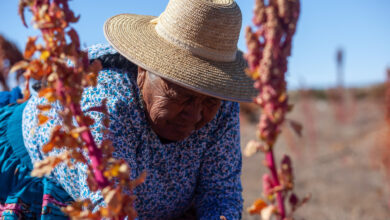These are the Latinos in the Marvel universe
These Latin American actors and actresses have embodied characters in Marvel productions in movies to television series .

These are some of the Latinos who make a presence in the Marvel universe. / Photos: IG-mvegapena, IG-juanpabloraba
LatinAmerican Post | Theoscar Mogollón González
Listen to this article
Leer en español: Estos son los latinos que han participado en el universo Marvel
Marvel comics have won the love of countless people around the world since the first publications in 1939 , when the editorial was called Timely Publications. Since then, the creation of the different characters in this universe over the years has exceeded several generations, to the point that today the passion for superheroes is bigger. This is how, we began to see those protagonists and villains moving to the small and big screen, something for which we are undoubtedly grateful.
In both movies and television series, the acting cast is full of talented people of different nationalities . That is why here we present a list of Latin actors and actresses (or Latin background) that you have surely seen in the productions of the Marvel universe.
Zoe Saldaña – Gamora
The actress with Caribbean roots conquered hundreds of fans with her role as Gamora in Guardians of the Galaxy and Avengers: Infinity War . Gamora is known to be the most dangerous woman in the universe, an expert in the use of all weapons and, also, adopted daughter of Thanos.
Benicio del Toro – The Collector
The Puerto Rican played Taneleer Tivan, better known as El Coleccionist, in several Marvel films. This character is an alien and obsessive collector of large collections of interstellar fauna, relics and species in the galaxy.
Lupita N'yongo – Nakia
Born in Mexico, the actress of Kenyan parents was one of those who made up the cast of Black Panther . Her character Nakia is an ally (and former crush) of T'Challa who serves Wakanda as a spy around the world.
Michael Peña – Luis
Beloved by many in the Marvel universe, the actor of Mexican descent plays a particular character. Luis is the best friend of Scott Lang (Ant-Man) and the cause of his breaking into the Pym residence. The reality is that, he is remembered more for his peculiar way of telling stories.
Salma Hayek – Ajak
The charming Mexican gets in this immense universe with the role of Ajak in The Eternals . This character belongs to a millennial alien race with powers whose mission is to protect planet Earth. It should be noted that, the film version of Ajak was gendered with the one he is known from in the comics.
Juan Pablo Raba – Joey Gutiérrez
The Colombian actor was part of the third season of the Agents of SHIELD series as José "Joey" Gutiérrez . This character is an non-human who obtained the ability to liquefy and reform metals. Having no control over his powers and after creating a chaotic situation in Seattle, a team of SHIELD agents intervened to take him to their secret base.
Also read: Everything we know about Falcon and the Winter Soldier
Natalia Córdova – Elena "Yo-Yo" Rodríguez
Also representing Mexico, this actress got the role of another nonhuman in Agents of SHIELD: Elena "Yo-Yo" Rodríguez . Her ability is to run at superhuman speed, and then return back to where he started. In her version for the TV series, she contacts the agency to investigate the theft of some weapons. Later he joins the Secret Warriors.
Gabriel Luna – Roberto Reyes
With Mexican descent, Gabriel is another of the Latinos with an appearance in Agents of SHIELD, playing Roberto Reyes or, rather, Ghost Rider . By being killed by a gang and later resurrected by Johnathon Blaze, Robbie acquires the powers of the Phantom Avenger. After a series of events, he helped SHIELD defeat Aida.
Rosario Dawson – Claire Temple
From Caribbean descent, her role spans several Marvel series, as Claire Temple is a nurse who cared for Matthew Murdock after completing her missions as Daredevil. Eventually Jessica Jones, Luke Cage, and Daniel Rand were found and helped medically. As a plus, we can add that Soledad Temple, her mother, is played by the Brazilian actress Sônia Braga .
Ramón Rodríguez – Bakuto
The character played by the Puerto Rican is that of a La Mano leader who tried to manipulate Daniel Rand from his side by capturing Madame Gao in the Marvel's Iron Fist series . Later, Bakuto is resurrected by The Hand to face the vigilante group in Marvel's The Defenders.
Tony Plana – Rafael Hernández
The Cuban actor has in Rafael Hernández the difficult task of being the Director of Operations of the Department of Homeland Security of the United States . With the help of Frank Castle, Hernández uncovers a conspiracy during the events of Marvel's The Punisher.
Oscar Isaac – Marc Spector
The Guatemalan actor will be in charge of bringing his character to life in the Disney + Moon Knight series . Marc is a vigilante with multiple personalities who became the Moon Knight after meeting Khonshu, the God of the moon in Egyptian mythology.




